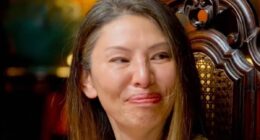After fleeing the downfall of her husband Bashar Al Assad’s regime, the former First Lady of Syria finds herself on the run. Once known as ‘A Rose in the Desert,’ she is now a despised figure, often compared to Lady Macbeth.
For many years, Asma Al Assad, now 49, was celebrated as a symbol of women’s empowerment in the Middle East. Her successful career in banking and her Westernized upbringing in Britain contributed to her public image.
She was born in London in 1975 to Fawaz Akhras, a prominent cardiologist at the prestigious Cromwell Hospital, and Sahar, a high-ranking Syrian diplomat. Asma attended Queen’s College in Marylebone, known for its expensive tuition fees nearing £9,000 per term.
From there she graduated at King’s College London in 1996 with a degree in computer science and French literature and embarked upon a career in investment banking at major companies including Deutsche Bank and JPMorgan.
Four years later she married Assad, now 59, in Syria in the same year he took over control of the country, after the death of his father, Hafez al-Assad, who died aged 69.
Together they have three children, who are aged between 19 and 23, and are presumed to be with their parents trying to find a safe haven.
On the international stage Mrs Assad cut a demure figure, with her understated attire and photogenic looks, her veilless face was emblematic of Syria’s reputation for relative freedom for women in a Muslim country.
This image seemed to be cemented when in February 2010, Vogue magazine called an interview with her ‘A Rose in the Desert’ describing her as the ‘freshest and most magnetic of first ladies’.

Bashar al-Assad and his wife Asma al-Assad pose during a visit to the Great Wall of China at Badaling on June 22, 2004

For years Asma was the face of female liberation in the Middle East; with her successful career in banking and her secular British upbringing

The couple during a visit to Schoenbrunn Palace in Vienna, Austria, on April 28, 2009
But the next year war broke out in Syria between rebels and Assad’s regime over his brutally repressive regime and the reputation of the country as open and secular was trashed.
During the conflict the couple are understood to have drifted apart, but with Assad’s mother dying in 2016 and Mrs Assad’s diagnosis of breast cancer in 2018, she was repositioned at the heart of the regime’s economy.
But this new role was nothing more than a ‘shakedown’ operation of the country’s middle class merchants and businessmen.
She orchestrated a secretive labyrinth of committees and policies, run by her henchman, which controlled everything from access to the internet to subsided food rations.
Her empire also extended to the distribution of foreign aid – effectively she controlled who got what when.
With her role within Assad’s dictatorship growing, she was unable to maintain her early image of the liberated woman operating at the heart of power in a Muslim country.
She became one and the same with the Syrian regime’s terrible suppression of its people.

The couple have three children, who are aged between 19 and 23, and are presumed to be with their parents trying to find a safe haven

Pictured is the house of the Ahkras family in West London

Al-Assad and his wife Asma arrive at official lunch held at the Hotel Marigny in Paris, France on July 14, 2008

Syrian president al-Assad and his wife Asma visit the Sednaya convent, and meet with children and religious personalities on Christmas day, in Sednaya, near Damascus, Syria on December 25, 2016

Asma became one and the same with the Syrian regime’s terrible suppression of its people
A personal low for her was when Vogue pulled its interview with her from its website in 2012 after public backlash to the war in Syria.
Despite the challenges to her public image, she was still seen on the international stage meeting with the heads of state in Europe.
But her role in Syria’s financial policy earned her the widespread, unenviable nickname of ‘Lady Macbeth’ from rebels and commentators alike.
And now, with rumours swirling that she and her husband are seeking haven in despotic regimes such as Russia and Iran, her once gilded facade has been torn asunder utterly.
In four days time the Assads will be marking their 24th wedding anniversary, in settings no doubt, less salubrious than their former palatial seat of power in Syria’s capital Damascus.
But where exactly they will share that marital moment, with their dynasty in tatters, and no clear picture for the future, is anyone’s guess.
Russia, a long standing ally of the Assad regime, cryptically announced the family had fled Damascus, and confirmed it is in talks with the rebel factions filling the void left behind, but did not confirm if the Assads had entered Russian territory.
Wherever, Mrs Assad and her fallen husband finds themselves holed up in the coming years, be it Moscow or Tehran, it is a long road back to Damascus.

Her empire also extended to the distribution of foreign aid – effectively she controlled who got what when

With rumours swirling that she and her husband are seeking haven in despotic regimes such as Russia and Iran, her once gilded facade has been torn asunder utterly
The home of Mrs Assad’s parents in West London, is a spacious terrace, with a brown stone front and white Edwardian glass panelled bay windows.
On neighbouring driveways rows of BMWs, Mercedes and Four by Four cars line up.
It is a quintessential middle-class street lined with trees, who have lost their leaves in December.
The houses fetch £600,000 to one million on average on the road, which is close to parks and busy shopping streets filled with boutiques, artisan bakeries, and cafes.
The in-laws of President Assad are said by neighbours not to have been seen for some time.
Nonetheless, their driveway is immaculately kept, with no obvious signs of disrepair on the paintwork of the black door and white window frames.
A large TV satellite dish protrudes from the front of the house, which is approached through a black gate and along a paved pathway.

















